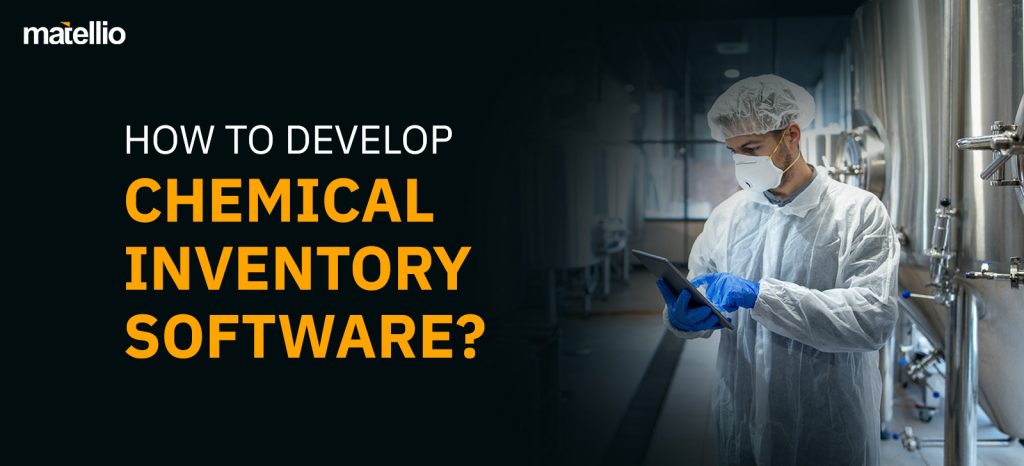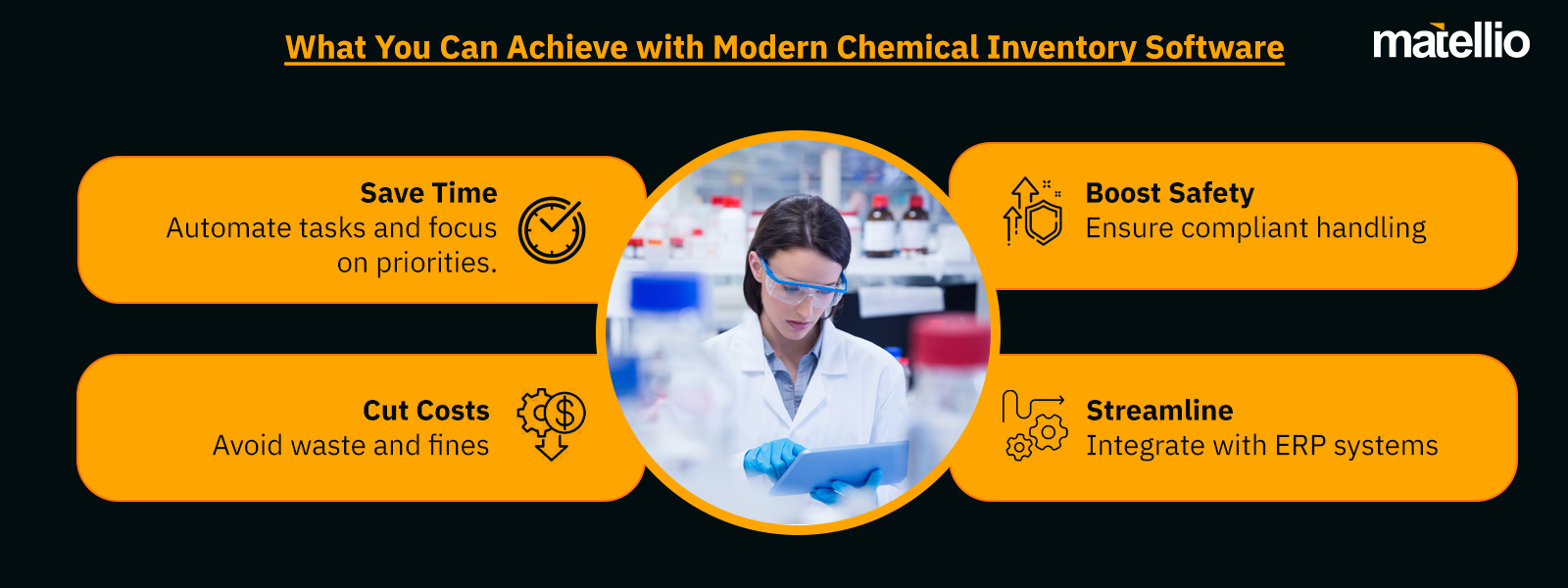
Did you know that the global chemical inventory software market is projected to reach USD 1.459 billion by 2031? Another analysis forecasts the market to grow at a CAGR of 11.4% between 2025 and 2029! But why is there a sudden surge in the chemical inventory management software market?
Ask yourself: How often have you spent hours searching for a chemical that was supposed to be on the shelf but wasn’t? Or had to discard expired reagents because no one tracked their shelf life? Maybe you’ve even faced a safety audit and scrambled to locate MSDS sheets or document chemical usage history.
These are the daily realities of running a lab or chemical warehouse, and let’s be honest—they’re not just frustrating, they’re costing you time, money, and peace of mind.
But not anymore when you have custom chemical inventory tracking software!
With chemical inventory software, you can streamline your entire operation, track stock with precision, ensure regulatory compliance, and even integrate tools like barcoding for fast, accurate updates. Intrigued?
Well, this can be a reality for you if you invest in chemical inventory software development today! And don’t worry – we have got your back. As a trusted digital transformation services company, we will guide you at every step of your transformation journey, from strategy creation to final deployment. Read the blog till last to discover everything about chemical inventory management software development. But first…
What is Chemical Inventory Software
At its core, chemical inventory management software is a centralized system that tracks every chemical in your inventory. From its location and quantity to its shelf life and associated safety data sheets (SDS), this software ensures nothing slips through the cracks.
But did you know that chemical inventory software is not limited to single type! Yes, you heard it right. There are various types of chemical inventory solutions that you can invest in depending on your business requirements and market demands. Let’s explore a few basic types below:
| Type of Software | Usage |
| Chemical Inventory Tracking Software |
|
| Chemical Compliance Management Software |
|
| Chemical Lot and Batch Tracking Software |
|
| Hazardous Materials Inventory Software |
|
| Chemical Procurement and Replenishment Software |
|
| Chemical Usage and Consumption Tracking Software |
|
| Chemical Expiry and Shelf-Life Management Software |
|
| Chemical Inventory Forecasting Software |
|
| Multi-Site Chemical Inventory Management Software |
|
| Real-Time Chemical Inventory Monitoring Software |
|
| Barcoding & RFID-Based Systems |
|
| Cloud-Based Chemical Inventory |
|
| Enterprise Resource Planning (ERP) Integrated Systems |
|
| Material Safety Data Sheet (MSDS) Management Systems |
|
| Automated Replenishment Software |
|
| Batch and Lot Tracking Software |
|
| Predictive Analytics Inventory Software |
|
| Laboratory Chemical Inventory Software |
|
Why Traditional Chemical Inventory Management Approaches Fail – The Need for Modern Inventory Solutions
Well, you have explored what exactly chemical inventory management software is, and what are its various types. But the main question is – why do you need to develop chemical inventory management software? Well, here are a few limitations of using traditional approached for chemical inventory management:
Manual Tracking is a Disaster Waiting to Happen
Spreadsheets and handwritten logs are slow, error-prone, and risky. One missed expiration date or incorrect stock count could lead to wasted chemicals, failed audits, or even dangerous accidents. With chemical inventory tracking software, you can automate these processes and eliminate costly mistakes.
Compliance is a Time Bomb Without Automation
Keeping up with OSHA and EPA regulations using outdated methods is overwhelming. Tracking SDS records manually puts you at risk of fines or shutdowns. A robust chemical inventory management solution ensures compliance is effortless, saving you time and avoiding penalties.
Stock Issues Are Bleeding Your Budget
Overstocking, running out of critical materials, or piling up dead stock wastes space, time, and money. Lab chemical inventory software provides real-time insights into stock levels, helping you manage resources efficiently and cut unnecessary costs.
You Can’t Scale with Outdated Tools
As your business grows, tracking thousands of chemicals manually becomes impossible. Inventory management software automates complex workflows and scales effortlessly, so you’re ready for the future.
But with chemical inventory software development, all these issues become a thing of the past

Investing in chemical inventory database software isn’t just about fixing what’s broken—it’s about building a foundation for growth, safety, and efficiency. The sooner you adopt it, the faster you’ll see the benefits.
Ready to Transform Your Business with Chemical Inventory Software? Begin with a Free 30-min Consultation!
The Key Benefits and Use Cases of Chemical Inventory Software
Running a chemical lab or warehouse isn’t just about storing and using chemicals—it’s about managing risk, meeting compliance, reducing waste, and ensuring smooth operations.
Let’s address real-world challenges you face daily and how chemical inventory software resolves them, all while integrating seamlessly into modern systems like an automated inventory tracking system or ERP tools.
Never Lose Track of Chemicals Again
Ever spent hours searching for a chemical, only to find it expired or misplaced? With chemical inventory tracking software, you know exactly where every bottle, drum, or vial is stored. Using chemical inventory software barcode capabilities, you can track a chemical’s location, usage, and quantity in seconds. This ensures nothing is wasted, lost, or overlooked, saving your team valuable time.
Automate Expiry and Hazard Alerts
Letting chemicals expire isn’t just wasteful—it’s dangerous. Whether it’s hazardous waste or a volatile material, unnoticed chemicals can lead to costly safety risks. Lab chemical inventory software automates alerts for approaching expiration dates or storage violations. Paired with an inventory tagging system, this ensures all your chemicals are accounted for and safely stored.
Avoid Overordering and Overstocking
How often have you overordered a chemical because stock levels weren’t properly tracked? Or worse, run out of a critical material mid-production? Chemical inventory tracking software provides real-time stock visibility and automatic reorder notifications. By integrating with AI and ML, you can predict usage trends and purchase only what’s needed, cutting storage costs and reducing waste.
Handle Hazardous Materials Safely
Improperly stored hazardous materials can cause accidents, fines, or worse. Chemical inventory management software ensures chemicals are stored correctly by tracking storage protocols, flagging potential hazards, and integrating with computer vision for inventory management to detect unsafe storage practices. This keeps your team safe while ensuring regulatory compliance.
Meet Audits Without Breaking a Sweat
Audits are a stress test for your processes. Searching for MSDS or SDS sheets, tracking hazardous materials, or compiling compliance reports can feel overwhelming. With chemical inventory management software, all your data is centralized and ready to generate compliance reports instantly. Whether it’s OSHA, EPA, or other standards, your business stays compliant with minimal effort. This efficiency can also be enhanced by leveraging RPA services for data handling and reporting.
Simplify Multi-Site Operations
Managing inventory across multiple labs or warehouses is chaotic without the right tools. With laboratory chemical inventory software, you can control and monitor inventory across all locations in one centralized platform. Whether it’s in Lab A, Warehouse B, or enroute to a client, you’ll always know its exact status.
Track Usage and Streamline Ordering
Knowing who used what and how much is critical to forecasting and budgeting. Chemical inventory database software logs every transaction—when a chemical was issued, who used it, and for what purpose.
Industries That Can Directly Benefit from Chemical Inventory Software
Who said chemical inventory software is limited to just one type of business? In fact, it’s a versatile solution that brings value across multiple industries.
Whether you’re managing raw materials, hazardous chemicals, or compliance-heavy operations, this software is a game-changer. Let’s explore the industries that stand to benefit the most from implementing chemical inventory software and how it can revolutionize their processes.
Pharmaceutical and Life Sciences
In the pharmaceutical industry, precision and compliance are everything. Managing chemicals for research, production, and quality control requires meticulous tracking of expiration dates, batch numbers, and hazardous materials. Laboratory chemical inventory software enables pharmaceutical companies to:
- Maintain compliance with FDA and ISO standards.
- Automate chemical tracking and batch recalls.
- Integrate seamlessly with AI development services to forecast chemical usage during drug development and manufacturing.
Manufacturing and Production
For manufacturers, especially those dealing with paints, adhesives, or chemical-based production lines, mismanaging inventory can halt production or result in overstocking. Chemical inventory tracking software provides:
- Real-time visibility into raw material availability.
- Alerts for low-stock or expired chemicals to avoid production delays.
- Integration with raw material inventory management software to ensure production workflows remain uninterrupted.
Oil and Gas
The oil and gas sector handles highly volatile and hazardous chemicals that require strict adherence to safety protocols. Chemical inventory management ensures:
- Safe storage of hazardous materials with built-in compliance tracking.
- Real-time inventory updates to prevent overstocking or understocking critical supplies.
- Smooth operations through automated inventory tracking systems that enhance productivity and minimize risks.
Educational and Research Laboratories
Universities and research institutions constantly handle small quantities of diverse chemicals, often spread across multiple labs. Without centralized tracking, chemicals expire, go missing, or are misused. Lab chemical inventory software helps by:
- Centralizing data on all chemicals and their SDS for easy reference.
- Ensuring chemicals are properly stored and used according to safety guidelines.
- Supporting scalability and streamlining workflows.
Food and Beverage Industry
Food manufacturers frequently use chemicals like cleaning agents, preservatives, and flavoring compounds. Mismanaging these can lead to contamination, production shutdowns, or regulatory fines. With chemical inventory software, food manufacturers can:
- Track chemical usage and ensure proper rotation of time-sensitive materials.
- Maintain compliance with FDA and HACCP requirements.
- Optimize procurement and reduce costs.
Cosmetics and Personal Care
From raw materials like essential oils and dyes to preservatives, the cosmetics industry handles hundreds of chemicals in its formulations. With chemical inventory database software, businesses in this sector can:
- Reduce waste by tracking material expiration dates.
- Maintain transparency and compliance with global regulations like REACH.
- Streamline operations with features like chemical inventory barcode scanning for faster material handling.
Environmental Services and Waste Management
Managing hazardous chemicals during disposal or recycling requires precise tracking to ensure compliance and safety. Chemical inventory management software offers:
- Real-time tracking of waste materials for safe disposal.
- Automated compliance reporting to meet EPA standards.
- Seamless integration with AI integration services for predictive waste management analytics.
To summarize, we have:
| Industry | Benefits |
| Pharmaceutical | Automated batch tracking, FDA compliance, waste reduction. |
| Manufacturing | Real-time raw material tracking, optimized reordering, reduced waste. |
| Oil and Gas | Hazard tracking, automated EPA reporting, safety compliance. |
| Educational Labs | Centralized chemical data, SDS management, scalable for lab growth. |
| Food and Beverage | FDA compliance, inventory rotation, contamination prevention. |
| Cosmetics | Expiration tracking, REACH compliance, predictive inventory needs. |
| Environmental Services | Hazard tracking, EPA reporting, optimized waste management. |
In short, investing in chemical inventory management software is more than just a technology upgrade—it’s the foundation for sustainable growth, higher profits, and operational excellence. Don’t wait until inefficiencies or non-compliance hurt your business; act now to secure your competitive edge.
Let’s Develop Your Business-focused Chemical Inventory Software Today. Fill Our Form to Get Started!
Tech Trends that Can Add Value to Your Chemical Inventory Software
You’ve already taken the smart step of considering chemical inventory management software for your business, but did you know you can amplify its capabilities even further? Yes, by integrating cutting-edge technologies, you can unlock even greater efficiency, compliance, and ROI.
However, choosing the right technologies can be overwhelming. That’s where our technology consulting services come in, making the process seamless for you. Below are five game-changing tech trends that can elevate your chemical inventory tracking software and give you unmatched value for your investment.
AI-Powered Predictive Analytics
Imagine knowing exactly when your chemicals will run out, which materials you’ll need next month, or how demand fluctuations will affect your inventory.
With AI inventory management software, predictive analytics uses historical and real-time data to forecast chemical usage and prevent stockouts or overstocking. By eliminating guesswork, you’ll reduce waste, optimize reorders, and improve your bottom line. It’s like having a crystal ball for your inventory—one that directly boosts ROI.
IoT Integration for Real-Time Monitoring
By integrating IoT sensors into your chemical inventory software, you can monitor temperature, humidity, and chemical conditions in real time. This is critical for businesses dealing with sensitive or volatile chemicals.
IoT integration services ensure chemicals are stored safely, preventing accidents and regulatory violations. Real-time alerts can notify you of any storage issues, allowing you to take immediate action and save valuable resources. Paired with an automated inventory tracking system, this can dramatically improve operational efficiency.
Cloud-Based Scalability and Accessibility
Running a growing business with multiple warehouses or lab locations? Cloud integration services for laboratory chemical inventory software ensures your data is accessible anywhere, anytime.
This allows teams across locations to collaborate effortlessly and access centralized inventory data. Cloud solutions also eliminate the need for costly on-premise infrastructure, making scaling your operations seamless and cost-effective. Whether you’re adding a new lab or expanding internationally, cloud-based scalability ensures you’re always one step ahead.
Computer Vision for Inventory Tagging and Management
Tired of manual inventory checks? Computer vision for inventory management automates this process using AI-powered cameras to scan, track, and update inventory in real-time.
This eliminates human errors and saves countless hours of manual labor. For chemical management, computer vision ensures every container is correctly labeled and accounted for, enhancing both accuracy and compliance. Combined with an inventory tagging system, this technology streamlines warehouse operations while cutting costs.
RPA (Robotic Process Automation) for Workflow Automation
Repetitive tasks like data entry, report generation, and SDS tracking can eat up your team’s time and lead to costly errors but not with RPA services.
By incorporating RPA services, you can automate these workflows within your chemical inventory database software. Imagine your system automatically generating compliance reports or updating stock levels as soon as materials are issued. With RPA, you’ll free up your team to focus on higher-value tasks while improving accuracy and operational speed.
With the right guidance, implementing these trends is seamless. The question isn’t whether you should upgrade—it’s how much you’ll gain when you do. Let’s begin today by scheduling a free 30-minute call with our technology consultants.
How To Develop Chemical Inventory Management Software
Developing chemical inventory management software tailored to your business needs is a transformative investment. But to get it right, you need a clear roadmap. From identifying your challenges to selecting the right tools and technologies, every decision matters. Follow these steps to build a solution that optimizes operations, ensures compliance, and maximizes ROI.
Define Your Objectives and Assess Your Needs
Before starting, take the time to ask yourself and your team these critical questions:
- What specific problems are you trying to solve? (e.g., compliance tracking, reducing waste, real-time monitoring).
- What features are essential for your business? (e.g., chemical inventory tracking software, automated reporting, barcode integration).
- Do you need integrations with existing systems like ERP or automated inventory tracking systems?
- How scalable does the system need to be for future growth?
Defining clear goals will guide the development process and ensure your chemical inventory software meets your specific requirements.
Partner with a Trusted Enterprise Software Development Company
Building custom laboratory chemical inventory software is a complex task that requires expertise in software engineering, compliance, and industry-specific needs. Partnering with an experienced company having expertise in enterprise software development services solves this purpose. But why is it crucial:
- Expert Guidance: They’ll help you identify the right tech stack, features, and integrations for your operations.
- Custom Solutions: A development company ensures the software is designed specifically for your industry, whether it’s pharmaceuticals, manufacturing, or oil and gas.
- Scalability and Flexibility: Experienced developers build solutions that grow with your business and adapt to future challenges.
- Post-Deployment Support: Continuous updates, maintenance, and troubleshooting are essential for long-term success.
By choosing the right partner, you ensure your chemical inventory management software aligns perfectly with your needs.
Choose the Right Tech Stack and Features
The technology stack is the backbone of your software. The right choices ensure smooth functionality, future scalability, and seamless integration. Work with your development team to incorporate:
- Front-End: React.js, Angular, Vue.js, Flutter (for mobile).
- Back-End: Node.js, Django, Spring Boot, Python, Java, PostgreSQL, MongoDB.
- AI/ML: TensorFlow, PyTorch, Scikit-learn, OpenAI API, Amazon SageMaker.
- Cloud Infrastructure: AWS, Azure, Google Cloud, Docker, Kubernetes.
- IoT Integration: AWS IoT Core, Azure IoT Hub, MQTT, IoT sensor APIs.
- RPA: UiPath, Blue Prism, Automation Anywhere.
- Barcode Integration: ZXing, Dynamsoft, Google Vision API.
- Security: OAuth 2.0, SSL/TLS, AES-256, AWS IAM, Azure AD.
Ensure the software includes essential features like chemical inventory software barcode scanning, SDS management, and real-time inventory tracking.
Focus on User Experience (UX) and Accessibility
The best chemical inventory tracking software isn’t just functional—it’s intuitive. Make sure the interface is user-friendly for workers at all levels, from warehouse staff to lab managers. Key considerations:
- Mobile-friendly interfaces for on-the-go inventory updates.
- Role-based access controls to ensure sensitive data is protected.
- Visual dashboards for quick insights into stock levels, usage trends, and compliance metrics.
A seamless UX reduces training time and ensures maximum adoption across your team.
Prioritize Compliance and Regulatory Standards
Compliance is non-negotiable in industries dealing with hazardous chemicals. Your chemical inventory management software should:
- Track and manage Safety Data Sheets (SDS) automatically.
- Generate real-time compliance reports for OSHA, EPA, and GHS standards.
- Include an inventory tagging system to monitor hazardous materials and their storage requirements.
Automating compliance ensures you avoid costly fines and build trust with regulators and clients.
Build an MVP First
Instead of building the entire system at once, start with a Minimum Viable Product (MVP). MVP development services focus on the most critical features, allowing you to:
- Test the software in a live environment.
- Gather feedback from your team to identify necessary adjustments.
- Scale the system gradually by adding advanced features like AI inventory management software or IoT integration.
This approach minimizes risks and ensures your final product meets your expectations.
Test Thoroughly and Iterate
Testing is crucial to ensure your software works flawlessly under real-world conditions. Key areas to focus on:
- Functionality Testing: Ensure all features, like chemical inventory tracking, SDS management, and barcode scanning, work as intended.
- Integration Testing: Verify that the software integrates smoothly with ERP systems, automated inventory tracking systems, and other tools.
- Load Testing: Test scalability by simulating large-scale chemical inventories.
- User Testing: Collect feedback from workers and managers to improve usability.
- Iterate based on the test results to create a robust and user-friendly solution.
Plan for Deployment and Ongoing Support
Deploying chemical inventory management software isn’t the end of the process—it’s the beginning of your digital transformation. Ensure your development partner provides:
- Comprehensive training for your team to maximize adoption.
- Continuous support for updates, security patches, and troubleshooting.
- Scalability options for adding advanced features as your business grows.
- This ensures your software remains a valuable asset for years to come.
Want to Know the Cost of Chemical Inventory Software Development? Share Your Requirements Today!
How Can Matellio Help
At Matellio, we don’t just build software—we craft tailored solutions that address your unique challenges, optimize your operations, and deliver measurable ROI. With years of experience in inventory management software development, we understand the complexities of the chemical industry, and we’re here to provide you with the most innovative and effective chemical inventory management software.
Here’s why partnering with us is the smartest choice for your business:
Tailored Software for Your Industry Needs
Every chemical factory has its own unique requirements, and we specialize in creating custom chemical inventory tracking software that aligns with your business goals. Whether you’re looking to manage hazardous materials, automate compliance tracking, or integrate IoT sensors for real-time monitoring, our solutions are built specifically for your operational workflows.
Expertise in Compliance and Regulatory Standards
The chemical industry is fraught with regulatory hurdles, from OSHA and EPA guidelines to GHS compliance. With Matellio, you can rest assured that your software will include automated compliance tools, SDS tracking, and real-time reporting features. Our expertise in software product development services ensures you never face penalties for non-compliance again.
Integration with Advanced Technologies
We elevate your chemical inventory management software with cutting-edge technologies like AI inventory management software, IoT for real-time tracking, and blockchain for traceability. By integrating these trends, we help you not only meet industry standards but exceed them, future-proofing your business in the process.
Seamless ERP and System Integration
Already have an ERP or warehouse management system in place? No problem. Our solutions integrate effortlessly with your existing tools, including automated inventory tracking systems and inventory tagging systems, ensuring smooth data flow and eliminating silos. This allows you to centralize operations without disrupting current workflows.
User-Friendly and Scalable Solutions
We design intuitive interfaces that workers, managers, and compliance teams can easily use without steep learning curves. Whether it’s lab chemical inventory software for small operations or a multi-location solution for global factories, our systems are scalable, ensuring they grow alongside your business.
Accelerated Deployment with Agile Methodology
Time is money, and Matellio ensures you get your chemical inventory database software up and running fast without compromising on quality. Using agile development practices, we break projects into manageable sprints, so you can see tangible results sooner. Plus, post-deployment, our RPA services can automate tedious workflows for even greater efficiency.
End-to-End Support and Maintenance
Our commitment doesn’t end with deployment. We provide continuous updates, maintenance, and troubleshooting, ensuring your chemical inventory management software remains secure, compliant, and optimized. With 24/7 support and proactive monitoring, we’re always here to ensure your software adapts to changing industry needs.
By partnering with us, you’re not just getting software—you’re gaining a long-term partner invested in your success. Let’s take your chemical inventory management to the next level. Contact us today to get started!
FAQs
Is chemical inventory software customizable?
Yes, custom chemical inventory software offers customization options to adapt to the specific needs of different industries or organizations, allowing users to tailor the software to their unique requirements.
Can the software integrate with other systems in the organization?
Integration capabilities are important for seamless data flow. Chemical inventory software can integrate with lab equipment, procurement systems, or other relevant databases.
How secure is the data stored in chemical inventory software?
Security features, such as data encryption, access controls, and regular backups, should be in place to protect sensitive information and ensure data integrity.
How can chemical inventory software improve safety?
The software helps prevent accidents, ensures proper handling, and facilitates quick emergency response by providing real-time information on chemical locations, quantities, and safety data.


